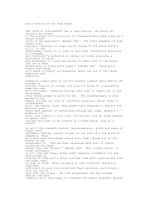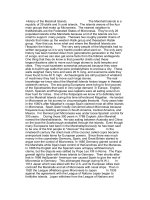BarCharts quickstudy history of the postage stamp
Bạn đang xem bản rút gọn của tài liệu. Xem và tải ngay bản đầy đủ của tài liệu tại đây (354.73 KB, 3 trang )
BarCharts, Inc.®
WORLD’S #1 ACADEMIC OUTLINE
HISTORY
Overview of the U.S. Postal Service
• When the Continental Congress named Benjamin Franklin the first Postmaster General in 1775, the United States was a weak confederation
of colonies scattered along the eastern seaboard.
• The postal system that the Congress created helped bind the new nation together, support the growth of commerce, and ensure a
free flow of ideas and information.
• In the more than two centuries since, the U.S. and the Postal Service have grown and changed together.
• Today, the Postal Service fuels the nation’s economy and delivers hundreds of millions of messages and billions of dollars in financial
transactions each day to eight million businesses and 250 million Americans.
• The Postal Service is making history, too, as it helps lead the way in making the federal government more businesslike and responsive
to customer needs.
Significant Dates in Postal History
• 1639- Richard Fairbanks’ tavern in Boston named
repository for overseas mail
• 1775- Benjamin Franklin, first Postmaster General
under Continental Congress
• 1789- Samuel Osgood, first Postmaster General
under Constitution
• 1823- Navigable waters designated post routes by
Congress
• 1825- Dead letter office
• 1829- Postmaster General joins Cabinet
• 1830- Office of Instructions and Mail
Depredations established; later called Office of
the Chief Postal Inspector
• 1838- Railroads designated post routes by
Congress
• 1845- Star routes
• 1847- Postage stamps
• 1852- Stamped envelopes
• 1855- Registered Mail; compulsory pre-payment
of postage
• 1858- Street letter boxes
• 1860- Pony Express
• 1862- Railway mail service, experimental
• 1863- Free city delivery; uniform postage rates,
regardless of distance; domestic mail divided into
three classes
• 1864- Post offices categorized by classes; railroad
post offices; domestic money orders
• 1869- Foreign or international money orders
• 1872- Congress enacts Mail Fraud Statute
• 1873- Penny postal card
• 1874- General Postal Union (later Universal
Postal Union)
• 1879- Domestic mail divided into four classes
• 1880- Congress establishes title of Chief Post
Office Inspector
• 1885- Special Delivery
• 1887- International parcel post
• 1893- First commemorative stamps
• 1896- Rural free delivery, experimental
• 1898- Private postcards authorized
• 1902- Rural free delivery, permanent
• 1911- Postal savings system; carriage of mail by
airplane sanctioned between Garden City and
Mineola, NY—Earle H. Ovington, first U. S. mail
pilot
• 1912- Village delivery
• 1913- Parcel post; insurance; collect-on-delivery
• 1914- Government-owned and operated vehicle
service
• 1916- Postal Inspectors solve last known
stagecoach robbery
• 1918- Airmail
• 1920- Metered postage; first transcontinental
airmail
• 1924- Regular transcontinental airmail service
• 1925- Special handling
• 1927- International airmail
• 1935- Trans-Pacific airmail
• 1939- Trans-Atlantic airmail; autogiro service,
experimental
• 1941- Highway post offices
• 1942- V-mail
• 1943- Postal zoning system in 124 major post
offices
• 1948- Parcel post international air service; parcel
post domestic air service
• 1950- Residential deliveries cut from two to one
a day
• 1953- Piggy-back mail service by trailers or
railroad flatcars; airlift
• 1955- Certified mail
• 1957- Citizens’ Stamp Advisory Committee
• 1959- Missile mail dispatched from submarine to
mainland Florida
• 1960- Facsimile mail
• 1963- ZIP Code and sectional center plan
• 1964- Self-service post offices; simplified postmark
• 1965- Optical scanner (ZIP Code reader tested)
• 1966- Postal savings system terminated
• 1967- Mandatory presorting by ZIP Code for
second- and third-class mailers
• 1968- Priority Mail, a subclass of First-Class Mail
• 1969- Patronage no longer a factor in postmaster
and rural carrier appointments; first die proof of a
postage stamp canceled on moon by Apollo 11
mission
• 1970- MAILGRAM; Postal Reorganization Act;
Express Mail, experimental
• 1971- Beginning of U.S. Postal Service operations;
Postmaster General no longer in Cabinet; labor
contract achieved through collective bargaining
for the first time in history of federal
government; star routes changed to highway
contract routes; national service standards
established—overnight delivery of 95% of airmail
within 600 miles and 95% of First-Class Mail
within local areas
• 1972- Stamps by mail; passport applications
accepted in post offices
• 1973- National service standards expanded to
include second-day delivery of parcel post
traveling up to 150 miles, with one-day delivery
time added for each additional 400 miles
1
• 1974- Highway post offices terminated; first
satellite transmission of MAILGRAMs
• 1976- Post office class categories eliminated;
discount for presorted First-Class Mail
• 1977- Airmail abolished as a separate rate
category; Express Mail, permanent new class of
service; final run of railroad post office on June 30
• 1978- Discount for presorted second-class mail;
postage stamps and other philatelic items
copyrighted
• 1979- Discount for presorted bulk third-class
mail; Postal Career Executive Service (PCES)
• 1980- New standards require envelopes and
postcards to be at least 31/2" high and 5" long to
be mailable; INTELPOST (high-speed international
electronic message service)
• 1981- Controlled circulation classification
discontinued; discount for First-Class Mail
presorted to carrier routes
• 1982- Automation begins with installation of
optical character readers; E-COM (Electronic
Computer-Originated Mail, electronic message
service with hard copy delivery)
• 1983- ZIP + 4; end of public service subsidy from
federal government
• 1984- Integrated retail terminals automate postal
windows
• 1985- Jackie Strange, first female Deputy
Postmaster General; E-COM terminated
• 1986- International Priority Airmail; Postal Service
realigned—field divisions created
• 1987- Small parcel and bundle sorters; stamps by
phone; multiline optical character readers
ordered
• 1988- Inspector General’s Act extends duties of
Chief Postal Inspector
• 1989- Universal Postal Union Congress in
Washington, DC
• 1990- Wide-area bar code readers; Easy Stamp,
allowing purchase of stamps through computers;
international business reply service
• 1991- Independent measurement of First-Class
Mail service
• 1992- Remote bar coding system;
reorganization—regions, divisions and
management sectional centers replaced by area
and district offices for customer service and mail
processing; stamps sold through automatic teller
machines
The Seal
History of the Postage Stamp*
• Before the use of adhesive paper stamps, letters were hand stamped or
postmarked with ink to mark the day and month the letter was mailed.
Postmarks were the invention of Henry Bishop and were originally called
“Bishop Marks”; they were first used in 1661 at the London General Post Office.
• A schoolmaster from England, Rowland Hill, invented the adhesive postage
stamp in 1837, an act for which he was knighted. He also created the first
uniform postage rates that were based on weight rather than size.
• On May 6, 1840, the British Penny Black stamp—the first stamp in the world—
was released. It was engraved with the profile of Queen Victoria, who remained
on all British stamps for the next 60 years.
• In 1847, U.S. stamps debuted.The first two featured George Washington and
Ben Franklin.
• In 1852, the first pre-stamped envelopes were sold. Pre-stamped postcards (for
a penny) appeared 19 years later.
• In 1855, pre-payment of postage became required in the U.S. (Up until that
point, some mail was still being sent without using stamps; the addressee had to
pay for delivery.)
• In 1857, perforated U.S. stamps appeared. (Previously, people had to cut apart
sheets of stamps.)
• By 1860, almost all countries had postage stamps.
• In 1869, the first U.S. pictorial stamps appeared. It was the first time U.S. stamps
showed something other than a deceased person.
• In 1893, the first U.S. commemorative stamps were issued.They depicted scenes
of Columbus’ voyage to America.
• In 1896, rural free delivery began bringing mail to homes in the country.
• In 1900, U.S. stamps were issued in booklet form for the first time.
• The first meters to pay postage were used in New Zealand in 1904.The first
use in the U.S. was on Dec. 10, 1920, in Stamford, Connecticut.
• In 1908, the first U.S. coil stamps (stamps sold in a roll only one stamp wide)
were released.
• In 1918, U.S. Airmail stamps went on sale for 24 cents.The U.S. began airmail
service on May 15, 1918. Special stamps were issued to indicate pre-payment of
mail carried on the first flights.The first route, flown by Army pilots in Army
planes, linked Washington, DC and New York City via Philadelphia, PA.The rate
was 24 cents an ounce.This rate included special delivery to the addressee.
• In 1940, Booker T.Washington became the first African-American honored on a
stamp.
• In 1957, the Citizen’s Stamp Advisory Committee was created to provide advice
to the Postmaster General on the subject matter and design of US stamps.
• In 1962, the first U.S. Christmas stamp was introduced.
• The Zone Improvement Plan (ZIP) code—a five-digit number—began on July 1,
1963.The first number designates the state or area; the next two numbers, the
area within that state or area; and the last two digits, the office itself. Mr. ZIP
was created to help people remember to use the ZIP code to help the Postal
Service move the mail. He was printed on the margins of many U.S. stamps
issued between 1964 and 1986.
• In 1964, the U.S. started printing stamps of different designs on one sheet,
known as se-tenants.The Christmas issue of 1964 was the first year different
designs were printed on the same pane of stamps. Four different stamps
featuring holly, mistletoe, poinsettia and a sprig of conifer were issued in panes
of 100 stamps, each pane containing 25 blocks of the four different stamps.
• In 1973,Valentine’s Day “Love” stamps were first issued.
• In 1974, the first U.S. self-adhesive stamp was issued.
• In 1992, full-scale production of U.S. self-adhesive stamps began.
• In 1997, the U.S. Postal Service introduced linerless coil self-adhesives, meaning
no backing paper on the stamps.
• In 1998, the U.S. Postal Service issued its first semi-postal stamps—postage
stamps which are used to raise funds for a charity.
* Taken from: www.stamps.org
2
• Mercury, a post rider, and now the eagle have symbolized the
postal system in the U.S. at various times in its history.
• In 1782, Postmaster General Ebenezer Hazard used the
figure of Mercury, the messenger of the gods and the god of
commerce and travel in Roman mythology. Mercury was
shown riding on clouds, with winged feet and a staff in his
right hand.
• A serpent-entwined staff was placed in Mercury’s extended
left hand by Postmaster General Gideon Granger in June
1808, until Postmaster General John McLean modified the
seal again in 1824 by placing Mercury's right hand at
shoulder height.
• The official seal used by the Post Office Department from
1837 to 1970 pictured, as directed by Postmaster General
Amos Kendall, “a post horse in speed, with mail bags and
rider, encircled by the words ‘Post Office Department,
United States of America.’”
• It is believed this seal was inspired by Benjamin Franklin.
When Franklin was selected Postmaster General by the
Continental Congress, he issued a circular letter throughout
the colonies that bore a rude woodcut of a post rider on
horseback, with saddle bags behind him for carrying the
mail.
• On Aug. 12, 1970, the day President Richard Nixon signed
into law the Postal Reorganization Act that converted the
Post Office Department into an independent establishment
of the executive branch, the Postal Service announced
adoption of a new seal.
• It featured a bald eagle poised for flight on a white field,
above red and blue bars framing the words “U.S. Mail” and
surrounded by a square border with the words “United
States Postal Service” on three sides and nine five-pointed
stars at the base.The stars carry no special symbolism.
How Rates Are Set
• The Board of Governors of the Postal Service proposes new rates to
the Postal Rate Commission (PRC).
• This proposal comes in the form of a formal request accompanied by
testimonies and analyses explaining the need for a rate increase and how
the various rate proposals were developed.
• The PRC has 10 months in which to render an opinion and a
recommended decision to the Governors. During that 10-month span,
the PRC conducts open hearings.
• During this process, the Postal Service answers questions from various
interested parties, such as customers, competitors and consumer
advocates, about the proposed rates.The interested parties critique
the Postal Service’s rate proposals and offer their own alternatives.
• If the PRC does not give a recommended decision to the Postal
Service after 10 months, the Postal Service may implement the
proposed rates temporarily.
• The Governors have several options after they receive the PRC’s
recommended decision:
° They may accept the recommended decision and, with the other two
members of the Board, order new rates into effect on a specific date.
° They may reject the PRC's recommended decision and return it
to the PRC for reconsideration. Current rates stay in effect.
° They may allow the recommended decision under protest;
acting with the other members of the Board, they can order
the new rates into effect on a specific date and return the
decision to the PRC for reconsideration or appeal the decision
to the courts.
° Finally, the Governors can modify the Commission’s second or
reconsidered decision by unanimous vote if they determine that
the recommended rates yield insufficient revenue.
Postal Rates Through the Years
Effective Date
Prepaid
1845, July 1
Under 300 miles, per 1/2 oz.
Over 300 miles, per 1/2 oz.
Drop letters
5 cents
10 cents
2 cents
1851, July 1
Up to 3,000 miles, per 1/2 oz.
Over 3,000 miles, per 1/2 oz.
Drop Letters
1855, April 1
Not over 3,000 miles, per 1/2 oz.
Over 3,000 miles, per 1/2 oz.
Drop letters
1863, July 1
Distance differential eliminated
All parts of United States, per 1/2 oz.
1883, Oct. 1
Letter rate reduced one-third
All parts of United States, per 1/2 oz.
1885, July 1
Weight increased to 1 oz.
All parts of United States, per 1 oz.
1917, Nov. 2
War emergency
All parts of United States, per 1 oz.
1919, July 1
Restoration of pre-war rate
All parts of United States, per 1 oz.
1932, July 6
Rise due to Depression
All parts of United States, per 1 oz.
1958, Aug. 1
All parts of United States, per 1 oz.
1963, Jan. 7
All parts of United States, per 1 oz.
3 cents
6 cents
1 cent
3 cents
10 cents
1 cent
3 cents
2 cents
2 cents
3 cents
2 cents
3 cents
4 cents
5 cents
Effective Date
Prepaid
1968, Jan. 7
All parts of United States, per 1 oz.
6 cents
1971, May 16
All parts of United States, per 1 oz.
1974, March 2
All parts of United States, per 1 oz.
1975, Dec. 31
All parts of United States, 1st oz.
1978, May 29
All parts of United States, 1st oz.
1981, March 22
All parts of United States, 1st oz.
1981, Nov. 1
All parts of United States, 1st oz.
1985, Feb. 17
All parts of United States, 1st oz.
1988, April 3
All parts of United States, 1st oz.
1991, Feb. 3
All parts of United States, 1st oz.
1995, Jan. 1
All parts of United States, 1st oz.
1999, Jan. 10
All parts of United States, 1st oz.
2001, Jan. 7
All parts of United States, 1 oz.
2006, Jan. 8
All parts of United States, 1 oz.
2007, May 14
All parts of United States, 1 oz.
Get the Answers You Need . . .
Do a
Laminated Reference Guides
8 cents
10 cents
13 cents
15 cents
18 cents
20 cents
22 cents
25 cents
29 cents
32 cents
33 cents
34 cents
39 cents
41 cents
Get the
Skills
You Need
with
®
Computer - Based Training
• Help Your Career
• Get a New Job
• Prepare as a Student
• Get Down to Business
Solutions for you or your employees
Browse Over 300 Titles • For school, computers, home, office and more • www.quickstudy.com
3









